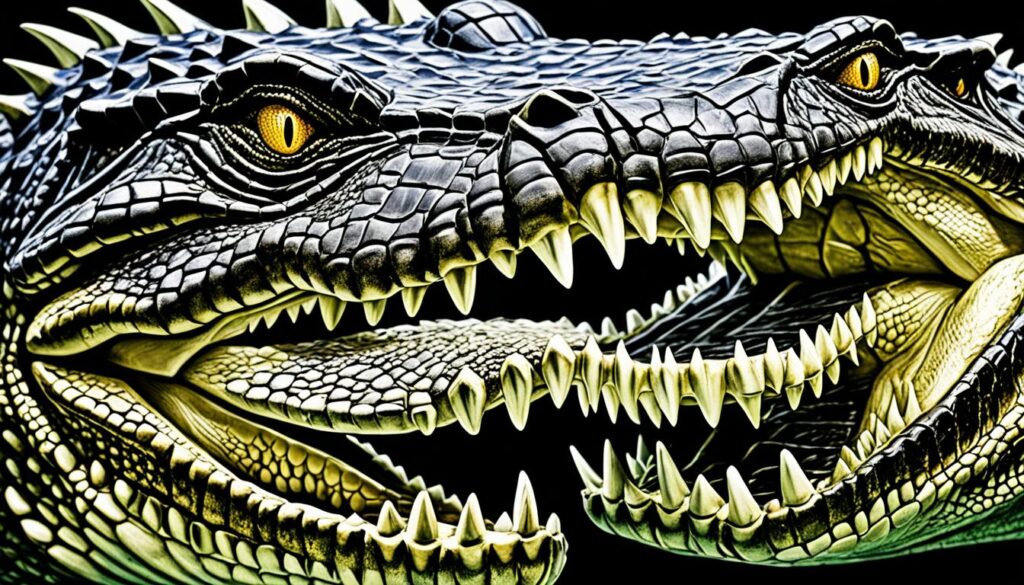When it comes to the animal kingdom, alligators and crocodiles are two fascinating creatures that often confuse people. While they may seem similar at first glance, there are several key differences that set them apart. In this article, we will explore the distinguishing characteristics of alligators and crocodiles, helping you understand what distinguishes one from the other.
Alligators and crocodiles belong to different families and have unique features that allow them to be told apart. From their snout shape to teeth visibility, color, size, and habitat, these differences can help you identify whether you’re dealing with an alligator or a crocodile.
So, what makes alligators and crocodiles different? Let’s dive in and find out!
Key Takeaways:
- Alligators and crocodiles have distinctive snout shapes. Alligators have a broad and rounded snout, while crocodiles have a narrow and pointed snout.
- Teeth visibility is another way to tell the difference. Crocodiles have visible lower and upper teeth, while alligators have hidden lower teeth.
- Alligators are usually dark gray, dark green, or black in color, while crocodiles are lighter green, grayish brown, or tan.
- Crocodiles can grow to be larger than alligators, reaching lengths of more than 20 feet, while alligators max out at around 14 feet in length.
- Alligators are found in the southern U.S. and China, while crocodiles inhabit tropical regions across Africa, Asia, Australia, and the Americas.
Snout Shape: A Key Feature to Differentiate Alligators and Crocodiles
One of the easiest ways to tell the difference between alligators and crocodiles is by examining the shape of their snouts. Alligators have a broad and rounded snout that is U-shaped, while crocodiles have a narrow and pointed snout that is V-shaped. This difference in snout shape is one of the most prominent distinguishing features between the two species.
When comparing the snout shape of alligators and crocodiles, it becomes clear how the U-shaped snout of alligators differs from the V-shaped snout of crocodiles. The snout shape is a result of their differing lifestyles and habitats.
Alligator Snout Shape: The U-shaped snout of alligators is adapted for their primarily freshwater habitat. This broad snout allows them to swim easily and navigate through the dense vegetation found in swamps, rivers, and lakes. The U-shape also provides more space for their teeth when their mouths are closed, as their lower teeth fit neatly within the upper jaw.
Crocodile Snout Shape: The V-shaped snout of crocodiles is designed for their diverse habitats, which include both freshwater and saltwater environments. The narrow snout enables them to swim swiftly and efficiently in open waters, such as rivers, estuaries, and coastal areas. The sharp, pointed snout also helps in catching and subduing their prey.
By identifying the snout shape, it becomes easier to discern between alligators and crocodiles. The U-shaped snout of alligators is well-suited for their freshwater habitats, whereas the V-shaped snout of crocodiles is adapted to their more varied environments.
Next, we’ll explore another distinguishing feature between alligators and crocodiles: their teeth.
Teeth: A Visible Distinction Between Alligators and Crocodiles
Another key difference between alligators and crocodiles lies in their teeth. Examining the teeth can provide valuable insights when trying to differentiate between the two species.
When the mouths of crocodiles are closed, both their lower and upper teeth are visible, adding to their fierce and intimidating appearance. This visible display of teeth is a characteristic feature of crocodiles that sets them apart.
In contrast, when the mouths of alligators are closed, their lower teeth remain hidden. This hidden teeth feature is a notable distinction from crocodiles and is one of the key identifiers of alligators.

The image above showcases the teeth structure of an alligator, emphasizing their hidden lower teeth. This unique dental arrangement is a significant characteristic to consider when differentiating between alligators and crocodiles.
Summary:
To summarize, alligators and crocodiles have distinct dental features that can be used to tell them apart. Crocodiles have visible lower and upper teeth, creating an intimidating appearance, while alligators have hidden lower teeth. Understanding these dental distinctions is crucial when identifying and distinguishing between alligators and crocodiles.
| Dental Feature | Alligator | Crocodile |
|---|---|---|
| Teeth Visibility | Hidden lower teeth | Visible lower and upper teeth |
Size and Habitat: Variances in Alligator and Crocodile Characteristics
Alligators and crocodiles exhibit notable differences in terms of their size and habitat. Understanding these distinctions can help differentiate between the two species. Let’s explore these variances below.
Alligator Size
Alligators typically reach a maximum length of around 14 feet. While there have been reports of larger individuals, these cases are rare. Therefore, it can be concluded that alligator length generally does not exceed 14 feet.
Crocodile Size
Crocodiles, on the other hand, are known to grow larger in size compared to alligators. Some crocodile species can reach lengths of over 20 feet, making them significantly larger than their alligator counterparts.
Alligator Habitat
Alligators are primarily found in freshwater habitats, with a preference for areas such as swamps, rivers, streams, and lakes. These environments provide the ideal conditions for alligator survival, as they offer abundant food sources and shelter.
Crocodile Habitat
Crocodiles exhibit a more diverse habitat range compared to alligators. They can thrive in both freshwater and saltwater environments, thanks to their unique ability to regulate salt levels in their bodies. As a result, crocodiles can be found in various regions, including tropical areas of Africa, Asia, Australia, and the Americas.
Overall, the differences in size and habitat between alligators and crocodiles showcase the adaptability and distinct characteristics of each species. The table below provides a summarized comparison of these contrasting features.
| Alligator | Crocodile | |
|---|---|---|
| Size (Length) | Average: Up to 14 feet | Average: Over 20 feet |
| Habitat | Freshwater areas such as swamps, rivers, streams, and lakes | Both freshwater and saltwater environments |
By analyzing their size, habitat, and other distinguishing characteristics, we can appreciate the unique qualities that differentiate alligators and crocodiles. Understanding these differences is essential for accurate identification and a broader appreciation of these fascinating reptiles.
Conclusion
In conclusion, understanding the key distinctions between alligators and crocodiles is essential for differentiating between the two species. By examining various characteristics such as snout shape, teeth visibility, size, color, and habitat, we can easily identify whether we’re encountering an alligator or a crocodile.
Alligators have a distinct U-shaped snout that is broad and rounded, while crocodiles have a V-shaped snout that is narrow and pointed. Additionally, when their mouths are closed, alligators hide their lower teeth, whereas crocodiles display both their lower and upper teeth.
Size and habitat are other differentiating factors, with crocodiles being larger in size, sometimes exceeding 20 feet in length, while alligators typically reach a maximum length of about 14 feet. Alligators tend to inhabit freshwater environments, such as swamps, rivers, streams, and lakes, while crocodiles possess the ability to adapt to both freshwater and saltwater habitats, providing a broader range of living options.
By taking into account these differences, we can confidently discern alligators from crocodiles and gain a deeper appreciation for the unique characteristics that each species possesses.
FAQ
What are the key differences between alligators and crocodiles?
Alligators and crocodiles have several distinguishing characteristics. Alligators have a broad and U-shaped snout, while crocodiles have a narrow and V-shaped snout. Crocodiles have visible lower and upper teeth when their mouths are closed, while alligators have hidden lower teeth. Alligators are usually dark gray, dark green, or black in color, while crocodiles are lighter green, grayish brown, or tan. Crocodiles can grow to be more than 20 feet long, while alligators usually max out at around 14 feet long. Alligators are found in the southern U.S. and China, while crocodiles are found in the tropical regions of Africa, Asia, Australia, and the Americas. Both species can be found in the Florida Everglades.
How can you tell the difference between an alligator and a crocodile?
One of the easiest ways to tell the difference between alligators and crocodiles is by examining the shape of their snouts. Alligators have a broad and rounded snout that is U-shaped, while crocodiles have a narrow and pointed snout that is V-shaped. This difference in snout shape is one of the most prominent distinguishing features between the two species.
Do alligators and crocodiles have different teeth?
Yes, alligators and crocodiles differ in terms of their teeth. When the mouths of crocodiles are closed, their lower and upper teeth are visible. In contrast, when the mouths of alligators are closed, their lower teeth are hidden. This distinction in teeth visibility is an important characteristic to consider when differentiating between the two species.
How do alligator and crocodile sizes and habitats differ?
Alligators and crocodiles differ in terms of their size and habitat. Crocodiles can grow to be larger than alligators, with some reaching lengths of more than 20 feet. Alligators, on the other hand, generally max out at around 14 feet in length. In terms of habitat, alligators are predominantly found in freshwater areas such as swamps, rivers, streams, and lakes. Crocodiles, on the other hand, can be found in both freshwater and saltwater environments, thanks to their ability to regulate salt. This adaptive feature allows crocodiles to inhabit a broader range of habitats compared to alligators.







